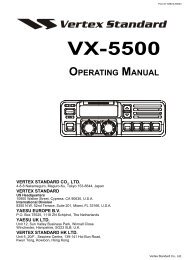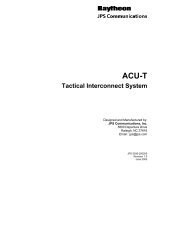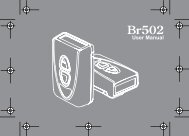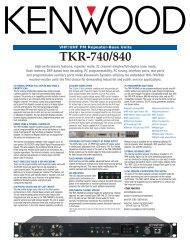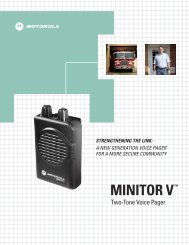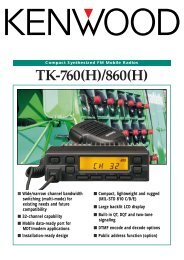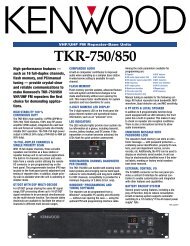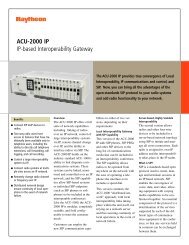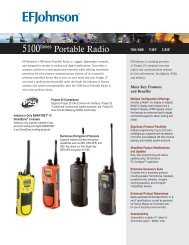DISTRIBUTED LOGIC TRUNKED RADIO SYSTEMS - Lauttamus ...
DISTRIBUTED LOGIC TRUNKED RADIO SYSTEMS - Lauttamus ...
DISTRIBUTED LOGIC TRUNKED RADIO SYSTEMS - Lauttamus ...
You also want an ePaper? Increase the reach of your titles
YUMPU automatically turns print PDFs into web optimized ePapers that Google loves.
12required (rather than the two required in control channel-based systems); end userinstructions when the proceed beep is enabled are simple: ‘Talk after the beep.’This handshaking process is duplicated when the called mobile unit responds to thecaller. In transmission-trunked systems, portions of a dispatch conversation exchangemay occur on a different repeater in the system, the system constantly reassigningrepeaters as needed, and doing so transparently to end users.If all channels in the system are busy with traffic, a ‘busy’ indication is displayed on themobile and its PTT is inhibited. If the mobile rekeys his transmitter a few seconds later, itis highly probable that a free channel will be available for assignment since there is nohang timer overhead and all channels are equally available for traffic. Because of thevery high statistical probability of channel access, transmission-trunked systems enjoy avery low probability of call blocking. Transmission-trunked systems are considered themost efficient form of analog trunking.If a mobile’s initial attempt to handshake with the system is unsuccessful (for example,because the mobile has ventured beyond the system’s coverage footprint), the radio willre-send the handshake REQ data packet up to 4 more times (5 attempts total) in rapidsequence while the PTT is held. If handshaking is still unsuccessful after 5 attempts, ano-service tone (a denial tone) will be heard in the mobile’s speaker.Typical Interconnect Operation:An interconnect ID (also known as RIC: Radio InterConnect) is assigned to those mobilesthat need access to the local PSTN. This gives the mobile the ability to make andreceive telephone calls. It is important to note that while all channels in a trunking systemare capable of dispatch operation, only those channels with special interconnectcontrollers are also capable of interconnect operation.For mobile-to-landline interconnect calls, the user selects an interconnect talkgroup ID (afront-panel mnemonic such as ‘PHONE’) and presses PTT. Kenwood trunked productswill attempt to access only those channels in a system that have been designated asinterconnect in the radio’s programming. Once access is made, the repeater’s controllervalidates this ID code as an interconnect ID and connects the repeater’s audio to thetelephone line. The requesting mobile hears the familiar Telco dial tone and dials thedesired number using his DTMF microphone or keypad.When the call is complete, the mobile presses ‘#’ to terminate the call or allows the call tosimply time out (the action of a mobile inactivity timer). If a call’s length approaches theallowable time limit for the privileges assigned to this ID code, a beep notifies the mobilehis time is about to expire, then a few seconds later a voice prompt notifies him that thecall timer has been exceeded and the interconnect call has been terminated.For landline-to-mobile calls, the interconnect controller is called like a normal telephone.When the controller answers, it voice-prompts the caller to overdial the mobile’s ID code(for example, 05221 for talkgroup 05-221). The mobile hears a telephone-like ‘ring’ fromthe radio’s speaker to indicate the incoming call, presses PTT to respond, and the callproceeds normally. Full duplex mobiles (a rarity today) allow conversations to proceedjust like a landline call; half-duplex mobiles require a PTT from the mobile when thetrunking system end user wishes to talk to the landline caller.Several fixed and variable timers are available to manage the airtime used on a per-IDbasis. Variable timers can be used to monitor overall system loading and dynamicallyadjust the maximum time allowed for interconnect calls during periods of high dispatchKENWOOD U.S.A. CORPORATION – COMMUNICATIONS DIVISION678-474-4700 voice 1-800-TRUNKING 678-474-4730 fax



